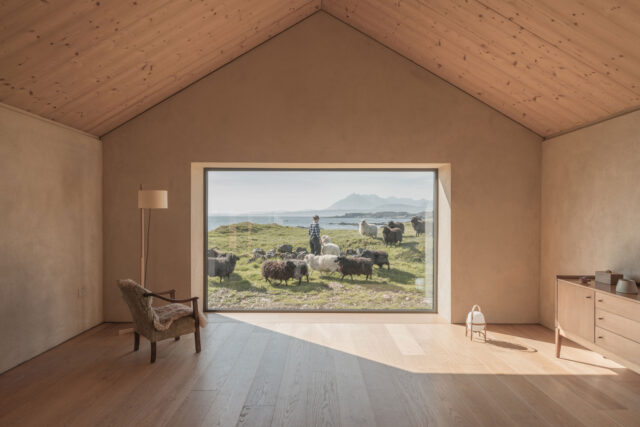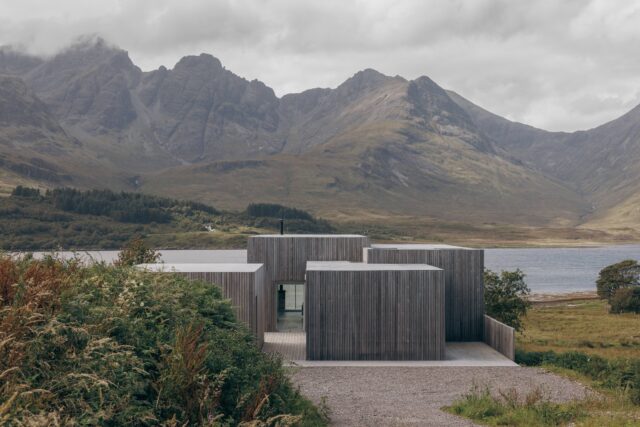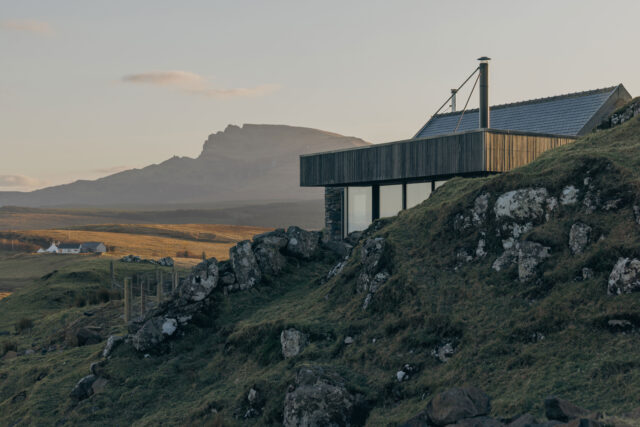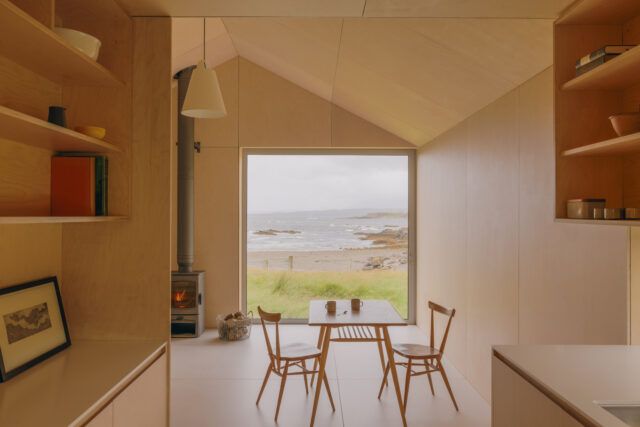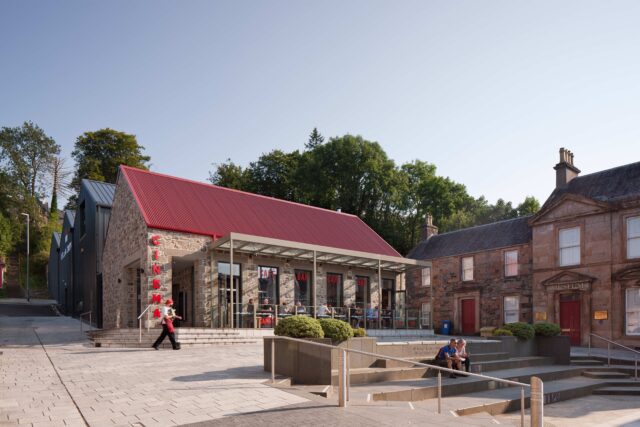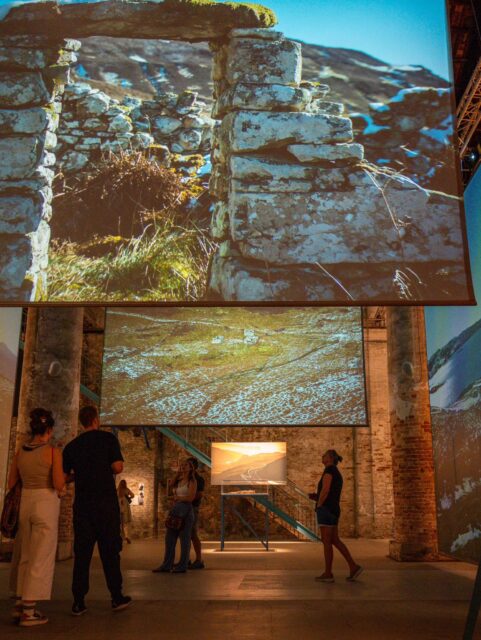Dualchas Architects
Category
Architectural Practice of the Year
Company
Dualchas
Summary
Since 1996 Dualchas* has not only been at the forefront of a renaissance in Highland architecture, but has shown that architecture inspired by context can work in any location. We always believed that good architecture must start from the place – it’s topography, culture and climate, and we continually strive to deliver on our ethos. In preparation to hit the exciting milestone of 30 years in practice, we have spent the last year reflecting on the past and planning for the future.
When Lesley Loki approached Dualchas Architects to exhibit at the 2023 Venice Architecture Biennale, she set out a clear reason why she wanted us to be there. She told us that our architecture is of a place, and does not try to reference what is happening in other places such as London. To her this story is important for emerging economies in Africa, who need the confidence to respect their own skills and culture.
Being told this by Lesley made us stop to think. Firstly, to understand what our story is, and secondly, that we needed help to tell our story. Led by the filmmaker Peter Marsden, we created an exhibit that explored our journey, our ethos and our close connection to the people, the culture and landscapes of the Highlands.
We remembered being told that the black house was the architecture of poverty, a building of shame. That what was done in the past should be forgotten and was of no value. We remembered the Western Isles Council digging holes in people’s crofts and burying their black houses. And we remembered that no one else was doing what many are now doing when we first started.
The Biennale year therefore gave us time to pause, look back and refocus, and we think that this shows through in the quality of our recent work. We are excited to showcase our Biennale exhibition movie in the Highland Cinema in Fort William this year, to share our believes that there is an immense value in the culture and the history of the Highlands, and that this could be drawn upon to create a modern, confident architecture.
*Dualchas is pronounced ‘doo -al -chas’ with a ‘ch’ as in loch. It can also be pronounced with a glide vowel ‘doo -al – i – chas’. The ‘d’ is soft and the ‘l’ is thick.
What sets your practice/agency apart from others?
At Dualchas we have a clear ethos; that truly sustainable architecture has a connection to the past and the place; architecture that will be cherished and cared for by future generations. By instilling community confidence and value in design it allows people to engage in ideas about what makes beautiful places, and encourages the development of our communities.The desire to understand a place - it's topography, culture and climate, has seen the Dualchas team take on commercial and public projects - as well as projects internationally. Within each design there is a focus on ideas promoting sustainability through the use of energy harnessing technology, the choice of materials in the build, and the life-use of the building.
Such exposure has allowed us to push forward our ethos: that good quality design should be a response to place. We believe it is the responsibility of architects to be advocates for the built environment to drive sustainability and excellence.
Last year has seen our team refocus on our goals and ambitions, and we believe that this can be seen in our latest work and in recognition by others. The Highland Cinema in Fort William was recognised for its role in revitalising the centre of Fort William and picked up the accolade of the best small cinema in the UK, as well as earning a well-deserved commendation for ‘Best Project Overall’ and winning award for ‘Place-Making’ from Highlands and Islands Architects Association. We also saw other projects picking up commendations and shortlistings for various awards (Taigh Crèadha – HIAA ‘Best New Building’, Craiglockhart Extension – GIA ‘Small Residential’ , Gartnerichnish – GIA ‘Small Residential’ and RIAS Awards), which is an achievement that any small practice would be proud of.
Throughout the years we have always believed that we have an obligation to nurture young talent and allow them to demonstrate what they can do. Our team takes pride in engaging with future generation of architects and strives to inspire their professional journeys. We have engaged in numerous activities, such as participating as reviews guests in Glasgow School of Art, joining the RIAS-GSA pilot mentoring programme for young students, presenting one off lectures at Robert Gordon University and University of Dundee, as well as having one of our staff as a part-time tutor at Strathclyde University. Earlier last year we have welcomed a group of Bolivian architectural students in our office for a day of discussions. While travelling in Europe, they were keen to learn from us about encouraging pride in heritage in order to build resilient communities. We were also invited to participate in a panel discussion ‘Wales in Venice’ which took place in Senedd, Cardiff, sharing our experience of representing Scotland on an international stage and showcasing our ethos and believes.
In 2024 we have taken time to revisit some of our past projects, to assess how our work stands the test of time. It offered us an opportunity to reflect on our experience and inspire future goals, driving the practice to continuously improve. This includes projects such as a Grade B listed 19th century Carnoch Church, which was converted into a two bedroom house in 2017. Coincidentally, the project has just won a ‘Best Rescued Ruin’ awards for British listed buildings from The Times. Another example is House at Boreraig, completed 13 years ago, which recently featured in Homes and Interiors Scotland. We are immensely proud that our past project continue to be appreciated for their architectural beauty many years later. We hope this gives our clients confidence in our understanding of the industry, our deep connection to heritage and our appreciation of the beautiful landscapes we live within.
How do you go 'the extra mile' for clients and employees?
We are a team of 17 based on Isle of Skye and Glasgow, with a couple of staff working remotely from other locations, which gives us a good understanding of both remote and urban living. We are mostly known for our one off houses in the remote highlands, but we also complete projects in towns and cities across UK. No matter the location, we believe that an approach which is deeply rooted in understanding of the natural and built environment will create a successful and resilient place.Although we are driven by a strong ethos, we never try to impose our ideas on the clients – it is about exploring ideas based around a response to the site, the climate, the materials and the brief. The result is a language of architecture that is distinctly of a place – that connects to what has gone before but is also a modern statement of what our environment is and can be. It is responsive yet restrained – trying to sit wihin the landscape rather than seek to shout out. It is this understanding which is at our heart and can be applied to all different locations – whether in Scotland or further afield, whether rural or urban. That we must observe, understand; and then design.
Our vast experience working on difficult sites and in remote locations, alongside our understanding of the importance of forging successful relationships with consultants and local contractors, allows us to bring together a strong team for our clients, which they are always a part of. We take our time to guide the clients through the journey step by step, helping them to understand their site and the building, so they can take an active part in decision making. And this must always be done thinking about the natural environment. How we design to reduce our carbon footprint, protect depleting natural resources, and support long-term ecological balance. No matter the scale or type of project, we are dedicated to delivering a professional service and client satisfaction - every project is important to us, and we always strive to achieve the best outcome possible.
It is important for anybody that joins our team that they understand our ethos. We design not just to create a good architecture – many practices do that. We design by being inspired by a place; to help improve and sustain communities, to care for our natural environment and to demonstrate to people that architecture can make their lives better.
We take a great pride in carefully selecting our staff and ensuring that we provide them with the best environment possible, to nurture creativity and sense of pride in our work. We believe that encouraging a well defined work-life balance creates happier working environment, which is reflected in our quality of work. We have recently introduced a 4.5 day working week, with a 1pm finish on Fridays, and last year has given us an opportunity to gather feedback and reflect. The results were better than we expected, with increased overall work satisfaction and engagement, as well as improved quality and no drop in quantity of the work.
We understand that our industry is a competitive place, and it can result in a busy and often stressful life. We’ve been continuously improving the collaboration between our two offices, to better resource our work and ensure that no one is left unsupported. We take pride in working as a team and believe that this allows us to deliver our projects more effectively and efficiently.
As a practice, we always keep busy, but never too busy to give a little of our time to important causes. We organise work charity events so we can all come together, alongside our families, and support causes particularly close to our heart. Last May we have completed a charity walk, raising over £6k for Sarcoma UK to fund Ewing sarcoma research.
We have introduced monthly events involving our staff across all locations, to give ourselves an opportunity to reconnect, bond and learn from one another. We believe that architects should be given a fair opportunity to focus on their families or other commitments which are of great importance to them. As such, a number our staff work part-time. This allows some to look after their children, and others to pursue their passions outside of work. We understand that this approach doesn’t diminish an individual’s ability to deliver quality work and we believe that this is something that the industry is still learning.
We believe that we create opportunities where our staff can feel that they are part of the Dualchas family. In this spirit, we also continue to invite them to yearly trips away, where we can show our appreciation for their hard work with good food, great company and time to relax and create strong bonds. We spend so much of our lives working, we believe that it’s important to create an environment where friendships can thrive.
What innovations have you introduced in the past year?
Over the last year we have taken the opportunity to revisit how topography, the climate and local culture can influence our work, with ambition to challenge ourselves further. We reflected upon traditional construction materials used to build dwellings in Scotland. The tectonic nature of historic construction methods, with materials such as stone, embraces the feeling of protection and shelter from the harsh environment, which mirrors the etymology of the word ‘dwell’ – to feel safe, preserved from harm and danger.Aiming to recreate this essential part of our built heritage with modern and sustainable materials, we successfully delivered two projects constructed from clay blocks over the last year. Similarly to stone, the clay blocks help to gently regulate the indoor temperature throughout the day by acting as thermal storage, provide great acoustic efficiency and breathability, and create a healthy indoor environment. Their embodied carbon is lower than that of standard blockwork, sometimes used as a stone alternative, and the simplicity of constructions bares strong resemblance to traditional stone masonry. One of these projects, Taigh Crèadha, was a private home for one of the founders of Dualchas and his family. This house of clay block and locally quarried terrazzo stone was directly influenced by the traditional black house, showing that despite all our diverse projects, we are still inspired by what we discover around us.
We are also excited to continue delivering one particular project in a northern, remote part of Scotland. This small scale housing development has a layout inspired by the traditional clachan. It will provide high quality affordable housing for a small remote community, and is set to be delivered using CLT. We have long encouraged the use of CLT on past project, albeit will limited success due to cost implications. However, we believe that an increase in demand for CLT will drive development of the local supply chain and eventually bring costs down, As such, we are enthusiastic to push for small but incremental changes such as this, whenever we have an opportunity to do so.
Following a year of hard work and dedication, we are also about to launch a new project called ‘Model Taigh’, where we seek to address the rural housing problem by delivering an affordable starter home in a kit form. We believe that as architects, we have an obligation to drive positive change and care for our fragile communities.
Lastly, we have spent the last year focusing on improving our skills. We are passionate about influencing our clients to strive for more sustainable solutions, and we have been dedicating time to researching local materials and further our knowledge of PassivHaus and EnerPhit. In the world where money is still a strong driver for private clients, we have seen a slow increase in appetite for sustainable designs, and we want to be at the forefront of encouraging and enabling change for the better. We believe it is the responsibility of architects to be advocates for the built environment and leaders within our community, and we intend to continue spreading the word – to architecture students, the general public, and politicians.


